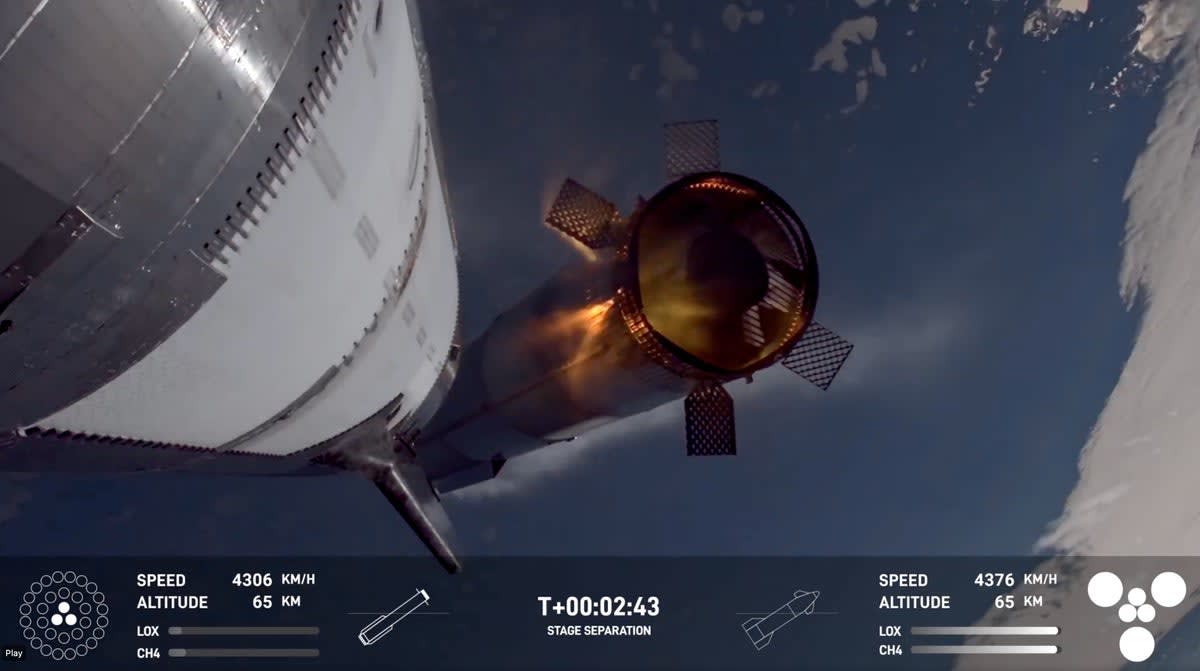SpaceX Starship Explosion Likely Caused by Propellant Leak, Elon Musk Says
The seventh test flight of SpaceX’s Starship ended with a successful landing of the rocket’s first stage but also the loss of the Starship vehicle
The two stages of SpaceX’s Starship megarocket separate during the vehicle’s seventh test flight on January 16, 2025. The upper stage was lost about six minutes later.
Join Our Community of Science Lovers!
The explosion that destroyed the upper stage of SpaceX’s Starship vehicle yesterday (Jan. 16) was likely caused by a leak, Elon Musk said.
Starship launched yesterday afternoon from SpaceX‘s Starbase site in South Texas, kicking of the seventh flight test of the 403-foot-tall (123 meters) megarocket.
Things went well initially. The vehicle’s two stages — the Super Heavy booster and Ship upper-stage spacecraft — separated on time, and Super Heavy returned to Starbase as planned, where it was caught by the launch tower’s “chopstick” arms.
If you’re enjoying this article, consider supporting our award-winning journalism by subscribing. By purchasing a subscription you are helping to ensure the future of impactful stories about the discoveries and ideas shaping our world today.
Ship ran into problems shortly after its partner’s big moment, however. The 171-foot-tall (52 m) spacecraft broke apart over the Atlantic Ocean roughly 8.5 minutes after liftoff, creating a sky show seen by observers in the Turks and Caicos islands and other nearby locales.
Though it’s still early in the anomaly investigation, SpaceX has already identified a likely cause, according to Musk, the company’s founder and CEO.
“Preliminary indication is that we had an oxygen/fuel leak in the cavity above the ship engine firewall that was large enough to build pressure in excess of the vent capacity. Apart from obviously double-checking for leaks, we will add fire suppression to that volume and probably increase vent area. Nothing so far suggests pushing next launch past next month,” Musk said via X, the social media platform he owns, about 2.5 hours after Flight 7 launched. (Starship’s Raptor engines are powered by liquid oxygen and liquid methane.)
As the latter part of that post indicates, SpaceX plans to fly Starship often in 2025; the company has applied for permission to launch the megarocket from Starbase up to 25 times this year.
That pressure overload apparently led to a fire “in the aft section of the ship, leading to a rapid unscheduled disassembly,” SpaceX wrote in a yesterday evening, stressing that this interpretation is based on initial data analyses. (“Rapid unscheduled disassembly” is a term of art for a spacecraft explosion.)
“We will conduct a thorough investigation, in coordination with the FAA, and implement corrective actions to make improvements on future Starship flight tests,” the company added, referring to the U.S. Federal Aviation Administration.
Still, the anomaly did have some effects beyond the SpaceX sphere. “The FAA briefly slowed and diverted aircraft around the area where space vehicle debris was falling,” agency officials told Space.com via email yesterday afternoon, noting that normal aircraft operations resumed shortly thereafter.
Mike Wall has been writing for Space.com since 2010. His book about the search for alien life, “Out There,” was published on Nov. 13, 2018. Before becoming a science writer, Michael worked as a herpetologist and wildlife biologist. He has a Ph.D. in evolutionary biology from the University of Sydney, Australia, a bachelor’s degree from the University of Arizona, and a graduate certificate in science writing from the University of California, Santa Cruz.
SPACE.com is the premier source of space exploration, innovation and astronomy news, chronicling (and celebrating) humanity’s ongoing expansion across the final frontier.
Source: www.scientificamerican.com
